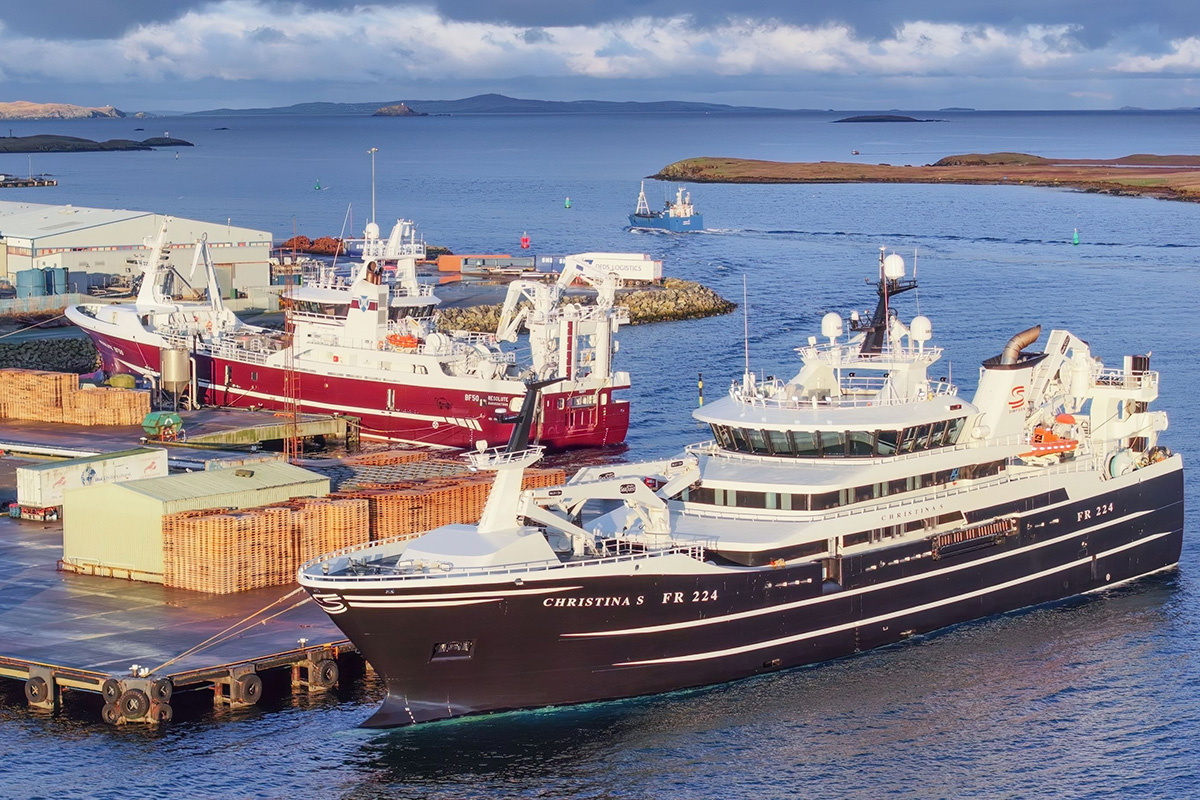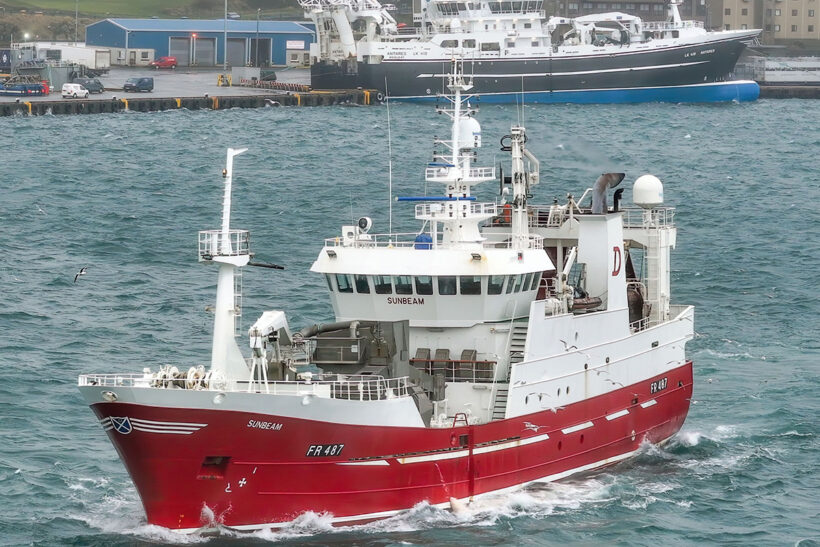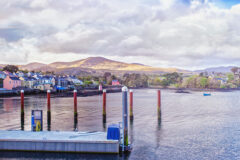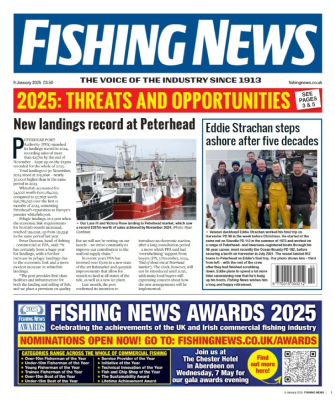Construction of a new quayside at Lerwick processor Pelagia Shetland is not expected to begin until next year – and it has been revealed that licence applications have not yet been submitted to the Scottish government.
The Shetland Fish Producers’ Organisation (SFPO) said that even 2026 might be optimistic, and that fishermen are unlikely to see the benefit of a bigger, faster Pelagia until the end of the decade.
In the meantime, pelagic vessels landing to Shetland are queuing up to use a single factory whose capacity skippers say is ‘mismatched’ with the volume of landings – forcing them to sell for lower prices and burn more fuel on shorter trips.
“It’s frustrating, and it’s a challenge, because there’s so many boats that want to get in here,” said skipper Alistair Irvine of the Zephyr LK 394, berthed up on the day his crew landed their last mackerel catch of the winter season. “We’re having to queue up here, and land older fish.”
He said he had initially hoped the factory might be able to process a greater capacity by autumn of this year.
His frustrations were shared by other crews queuing up to land. “It’s actually a problem,” said James Duthie, mate of the Fraserburgh-registered Sunbeam (pictured above) as the trawler was waiting to land in early January.
“Unfortunately the prices are much better in Norway – that’s the gripe,” said Mr Duthie. “If it was a level pricing, we’d be fine.”
Egil Magne Haugstad, chief executive of Norway- headquartered Pelagia, said the company was ‘currently waiting for the formal approvals from government’ for the quayside construction to go ahead. The Scottish Marine Directorate, however, confirmed that no application had yet been filed. Lerwick Port Authority (LPA), which is responsible for filing applications on behalf of Pelagia, said it was still ‘collating the information required to accompany the licence application’.
The new quayside is part of a package of developments at the processing factory, made more urgent by the increased requirements for Scottish vessels to land key species in Scotland.
Over the past three years, the Scottish government has gradually raised the proportion of fish that larger Scottish vessels are required to land in the country, even as the sector warned that processing capacity would struggle to keep up. This year, the landing requirement has risen to 55% for species including mackerel and herring.
“We have highlighted from the outset that the government will create a mismatch,” said Brian Isbister, chief executive of the SFPO, which represents the islands’ fleet of seven pelagic trawlers. “Something’s got to give.”
Mr Isbister said that while he is ‘encouraged’ by the proposals to expand Pelagia Shetland, he suspects that it will be ‘several years down the line’ before they come to fruition.
“I don’t think there is detailed planning exactly for what is being proposed beyond the conceptual stage,” he said. “I’m not convinced that any of that’s been properly considered. I think we’re looking at the latter end of this decade before everything proposed is up and running here.”
Meanwhile, Shetland’s pelagic vessels are not just forced to accept lower prices – whether because they cannot land more fish in Norway, or because their catch has had to wait in a harbour queue to land – but also to make more frequent trips to land smaller catches.
That inefficiency makes the whole fleet more carbon-intensive, and adds a fuel cost for skippers.
“We’ve always preferred landing in Shetland anyway,” said Alistair Irvine. “But it’s affecting us now because of the price difference compared to Norway.”
Some works have been undertaken in recent years to expand the Lerwick factory. In 2023, the port authority finished a land reclamation project next to the factory, mostly funded by Defra, where Pelagia hopes to site a new cold storage facility.
While this will enable the factory to take landings from vessels faster than it can fully process the fish, a new quayside would increase the total weight the factory can take from boats at any one time. “That’d be a help,” said Mr Irvine.

With fishing concentrated west of Shetland and the proportion of mackerel catches that must be landed in Scotland up to 55% in 2025, Pelagia Shetland has seen a busy winter mackerel season. Here, Resolute BF 50 is discharging – with Christina S FR 224 in the queue. (Photos: Ivan Reid)
The factory’s current capacity sits between 600t and 650t a day. Construction of the new cold storage was due to start in 2024, according to the Scottish Pelagic Fishermen’s Association, but is yet to begin. LPA chief executive Calum Grains said work would be undertaken to address the issue.
“Lerwick Port Authority completed a reclamation project at Arlanda, Gremista, to allow for the building of a new cold store by Pelagia Shetland,” he said.
“The authority is currently undertaking work to gain a marine licence to rebuild quayside at Gremista. On completion of the new quayside, this new infrastructure will support the further expansion of the pelagic processing sector.”
Neither LPA nor Pelagia responded to questions about the delay.
The Scottish government said it raised the landing requirement to ‘encourage’ more boats into the nation’s ports and thereby boost the economy. “In relation to mackerel alone, around a dozen vessels were landing over £100m of the species abroad each year,” a spokesperson said.
“The amended provisions have seen increased landings of mackerel and herring into Shetland and elsewhere in Scotland – helping to widen the social and economic benefit from Scotland’s quotas beyond those involved in catching these species.”
But for Shetland’s pelagic fleet that principle, and the future expansion it presupposes in Scottish processing factories, is doubly ironic.
First, said Alistair Irvine, Pelagia is hardly a Scottish institution. “The factory is owned by Pelagia in Norway anyway,” he said. “It’s just another one of their factories that happens to be in Shetland.”
The factory has been operated by Pelagia Shetland, the Norwegian company’s local subsidiary, since it bought a majority share in Shetland Catch almost a decade ago.
Secondly, there is the question of whether more fish landed here will lead to more Scottish jobs. “For fish factories to be competitive in this country, they’ve got to be modern and efficient,” said Brian Isbister.
“The modern equivalents to what we’ve got in Scotland today don’t actually employ more people – they probably employ far fewer.
“It seems like this is a situation where political ambition has run ahead of itself.”
For the pelagic fleet, the issue of mackerel landings is now on the back burner, as the winter season draws to a close – but the same issue will arise with the start of the herring fishery.
The Zephyr has now switched out her nets for the blue whiting fishery off Ireland, but already Alistair Irvine is planning for the rest of the year’s mackerel come autumn – where to land, and how to avoid queues at Pelagia.
“It’s just a business,” he said, “and we feel we’ve been slightly taken advantage of.”
This story was taken from the latest issue of Fishing News. For more up-to-date and in-depth reports on the UK and Irish commercial fishing sector, subscribe to Fishing News here or buy the latest single issue for just £3.50 here.
Sign up to Fishing News’ FREE e-newsletter here.





